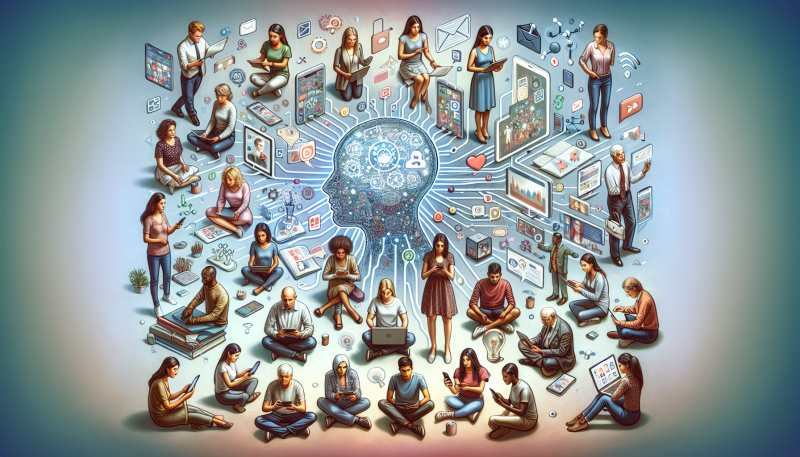
The Impact of AI on Content Diversity
In today’s rapidly evolving digital landscape, the impact of AI on content diversity is becoming increasingly significant. As businesses and professionals strive to create engaging and relevant content, the integration of artificial intelligence tools has transformed the way we approach content creation and management. JAXI.AI, an AI-powered content creation and writing assistant, is at the forefront of this revolution, empowering users to enhance their digital content strategies with precision and creativity. By leveraging advanced natural language processing algorithms, JAXI.AI not only simplifies the crafting of professional blogs and articles but also ensures that the content produced is diverse, engaging, and optimized for search engines.
With features like auto blogging and AI tools for generating marketing copy, social media posts, and more, JAXI.AI enables brands to maintain a strong online presence while catering to their audience’s interests. As we explore the profound effects of AI on content diversity, we will uncover how these innovations are reshaping the way we communicate, engage, and connect with our audiences. Join us as we delve into the transformative role of AI in content creation and discover how JAXI.AI can help you stay ahead in this dynamic digital environment.
Enhancing Creative Expression Through AI Tools
Artificial Intelligence (AI) is transforming the landscape of creative expression, offering innovative tools that empower artists, writers, musicians, and content creators to explore new dimensions of their craft. The integration of AI into creative processes is not merely a trend; it represents a significant shift in how content is generated, refined, and diversified. By harnessing the capabilities of AI, creators can enhance their artistic expression, streamline their workflows, and ultimately produce more diverse and engaging content.
One of the most compelling aspects of AI in creative fields is its ability to generate ideas and content that might not have been conceived through traditional methods. For instance, AI algorithms can analyze vast amounts of data, including existing works of art, literature, and music, to identify patterns and trends. This analysis can inspire creators to explore new themes, styles, and formats. As a result, artists can push the boundaries of their creativity, leading to a richer tapestry of content that reflects a wider range of perspectives and experiences.
AI tools such as natural language processing (NLP) and machine learning algorithms are particularly beneficial for writers. These technologies can assist in brainstorming ideas, generating outlines, and even drafting entire articles or stories. For example, platforms like OpenAI’s GPT-3 have demonstrated the ability to produce coherent and contextually relevant text based on prompts provided by users. This capability allows writers to overcome creative blocks and explore new narrative possibilities. Moreover, AI can analyze audience preferences and engagement metrics, enabling writers to tailor their content to meet the demands of diverse audiences.
In the realm of visual arts, AI has made significant strides as well. Tools like DeepArt and DALL-E allow artists to create stunning visuals by leveraging neural networks that can mimic various artistic styles. These tools not only enhance the creative process but also democratize art creation, enabling individuals without formal training to produce visually appealing works. This accessibility fosters a more inclusive artistic community, where diverse voices and styles can flourish.
Music composition is another area where AI is making a profound impact. AI-driven platforms can analyze musical patterns and generate original compositions that blend different genres and styles. For instance, AIVA (Artificial Intelligence Virtual Artist) is an AI composer that creates music for various applications, from film scores to video game soundtracks. By collaborating with AI, musicians can experiment with new sounds and structures, leading to innovative compositions that reflect a fusion of human creativity and machine intelligence.
The role of AI in enhancing creative expression extends beyond mere content generation. AI tools can also assist in the editing and refinement stages of the creative process. For example, AI-powered editing software can analyze written content for grammar, style, and tone, providing suggestions that help writers polish their work. Similarly, visual editing tools can enhance images and videos, ensuring that the final product meets high standards of quality and creativity.
Moreover, AI can facilitate collaboration among creators from different backgrounds and disciplines. Platforms that integrate AI can connect artists, writers, and musicians, allowing them to share ideas and collaborate on projects in real-time. This collaborative environment fosters a culture of creativity and innovation, where diverse perspectives can converge to produce unique and compelling content.
As AI continues to evolve, its potential to enhance creative expression will only grow. The future of content creation will likely see even more sophisticated AI tools that can understand and respond to human emotions, preferences, and cultural nuances. This evolution will enable creators to produce content that resonates deeply with audiences, reflecting the complexities of human experience in a diverse and interconnected world.
In conclusion, the integration of AI tools into creative expression is revolutionizing the way content is generated and experienced. By providing innovative solutions for idea generation, content creation, and collaboration, AI is enhancing the diversity of creative outputs. As artists and creators embrace these technologies, they are not only expanding their own creative horizons but also contributing to a richer and more varied cultural landscape. The impact of AI on content diversity is profound, and its potential to shape the future of creative expression is limitless.
For further insights into how AI is transforming various aspects of content creation, you may explore the following resources:
- How AI is Revolutionizing Business Blogging
- The Benefits of AI in Digital Content Strategy
- How AI is Transforming Content Creation
"AI is not just a tool; it is a partner in the creative process, enabling us to explore uncharted territories of imagination."
Balancing Automation and Authenticity in Content Creation
In the rapidly evolving landscape of content creation, the integration of artificial intelligence has sparked a significant transformation. As businesses and creators increasingly turn to AI tools for generating content, the challenge lies in striking a balance between automation and authenticity. While AI can enhance efficiency and streamline processes, it is crucial to ensure that the content produced resonates with audiences on a personal level. The essence of effective content lies not only in its ability to inform or entertain but also in its capacity to connect with readers emotionally and authentically.
Automation through AI offers numerous advantages, such as the ability to analyze vast amounts of data, identify trends, and generate content at an unprecedented speed. This capability allows creators to produce a higher volume of content, catering to diverse audience preferences and increasing the likelihood of engagement. However, the risk of over-reliance on automation is that it can lead to a homogenization of content. When multiple creators utilize similar AI tools, the uniqueness and individuality of each piece may diminish, resulting in a sea of generic content that fails to stand out.
To maintain authenticity, content creators must infuse their unique voice and perspective into their work. This involves leveraging AI as a supportive tool rather than a replacement for human creativity. By using AI to handle repetitive tasks, such as data analysis or keyword optimization, creators can free up their time to focus on crafting compelling narratives that reflect their personal experiences and insights. This approach not only enhances the quality of the content but also fosters a deeper connection with the audience.
Moreover, understanding the audience’s needs and preferences is essential in creating authentic content. AI can assist in this regard by providing valuable insights into audience behavior and preferences. By analyzing engagement metrics and feedback, creators can tailor their content to better resonate with their target demographic. This data-driven approach, when combined with a human touch, can lead to the creation of content that is both relevant and relatable.
Another critical aspect of balancing automation and authenticity is transparency. Audiences today are increasingly aware of the role of AI in content creation. They value honesty and authenticity, and they can often discern when content lacks a genuine human touch. Therefore, it is essential for creators to be transparent about their use of AI tools and to ensure that the final output reflects their unique voice and values. This transparency not only builds trust with the audience but also reinforces the creator’s brand identity.
In conclusion, the integration of AI in content creation presents both opportunities and challenges. While automation can enhance efficiency and broaden content diversity, it is vital to prioritize authenticity to foster meaningful connections with audiences. By leveraging AI as a tool to support creativity rather than replace it, content creators can produce work that is not only diverse but also rich in authenticity. This balance will ultimately lead to more engaging and impactful content that resonates with readers on a deeper level. For more insights on how AI is transforming content creation, you can explore this article or learn about the benefits of AI in digital content strategy.
In conclusion, the impact of AI on content diversity is profound and multifaceted. As artificial intelligence continues to evolve, it offers unprecedented opportunities for creators to explore new ideas, styles, and formats, ultimately enriching the landscape of content. However, it also presents challenges, such as the risk of homogenization and the potential for bias in algorithm-driven recommendations. To harness the full potential of AI while preserving and promoting diversity, it is essential for content creators, platforms, and consumers to remain vigilant and proactive. By prioritizing inclusivity, encouraging diverse voices, and critically engaging with AI tools, we can ensure that the digital content ecosystem remains vibrant, varied, and representative of the rich tapestry of human experience. As we navigate this new frontier, the collaboration between technology and creativity will be key to fostering a diverse and dynamic content landscape that resonates with audiences around the world.

